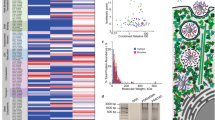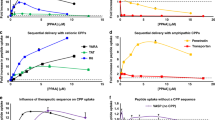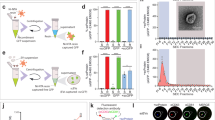Abstract
The interaction between cationic DNA-containing particles and cell surface anionic proteoglycans is an efficient means of entering cultured cells. Therapeutic in vivo gene delivery levels, however, require binding to less ubiquitous molecules. In an effort to follow adenovirus, thiol-derivatized polyethylenimine (PEI) was conjugated to the integrin-binding peptid CYGGRGDTP via a disulfide bridge. The most extensively conjugated derivative (5.5% of the PEI aminefunctions) showed physical properties of interest for systemic gene delivery. In the presence of excess PEI-RGD, plasmid DNA was condensed into a rather homogeneous population of 30–100 nm toroidal particles as revealed by electron microscopy images in 150 mM salt. Their surface charge was close to neutrality as a consequence of the shielding effect of the prominent zwitterionic peptide residues. Transfection efficiency of integrin-expressing epithelial (HeLa) and fibroblast (MRC5) cells was increased by 10- to 100-fold as compared with PEI, even in serum. This large enhancement factor was lost when aspartic acid was replaced by glutamic acid in the targeted peptide sequence (RGD/RGE), confirming the involvement of integrins in transfection. PEI-RGD/DNA complexes thus share with adenovirus constitutive properties such as size and a centrally protected DNA core, and ‘early properties, ie cell entry mediated by integrins and acid-triggered endosome escape.
This is a preview of subscription content, access via your institution
Access options
Subscribe to this journal
Receive 12 print issues and online access
$259.00 per year
only $21.58 per issue
Buy this article
- Purchase on Springer Link
- Instant access to full article PDF
Prices may be subject to local taxes which are calculated during checkout








Similar content being viewed by others
References
Behr JP, Demeneix B, Loeffler J, Perez-Mutul J . Efficient gene transfer into mammalian primary endocrine cells with lipopolyamine-coated DNA Proc Natl Acad Sci USA 1989 86: 6982–6986
Mislick KA, Baldeschwieler JD . Evidence for the role of proteoglycans in cation-mediated gene transfer Proc Natl Acad Sci USA 1996 93: 12349–12354
Labat-Moleur F et al. An electron microscopy study into the mechanism of gene transfer with lipopolyamines Gene Therapy 1996 3: 1010–1017
Plank C, Mechtler K, Szoka FC, Wagner E . Activation of the complement system by synthetic DNA complexes: a potential barrier for intravenous gene delivery Hum Gene Ther 1996 7: 1437–1446
Frese J, Wu CH, Wu GY . Targeting of genes to the liver with glycoprotein carriers Adv Drug Delivery Rev 1994 14: 137–152
Monsigny M, Roche AC, Midoux P, Mayer R . Glycoconjugates as carriers for specific delivery of therapeutic drugs and genes Adv Drug Delivery Rev 1994 14: 1–24
Wagner E, Curiel D, Cotten M . Delivery of drugs, proteins and genes into cells using transferrin as a ligand for receptor-mediated endocytosis Adv Drug Delivery Rev 1994 14: 113–135
Wu GY et al. Receptor-mediated gene delivery in vivo – partial correction of genetic analbuminemia in nagase rats J Biol Chem 1991 266: 14338–14342
Perales JC, Ferkol T, Molas M, Hanson MR . An evaluation of receptor-mediated gene transfer using synthetic DNA–ligand complexes Eur J Biochem 1994 226: 255–266
Cotten M et al. Transferrin-polycation-mediated introduction of DNA into human leukemic cells: stimulation by agents that affect the survival of transfected DNA or modulate transferrin receptor levels Proc Natl Acad Sci USA 1990 87: 4033–4037
Plank C et al. Gene transfer into hepatocytes using asialoglycoprotein receptor mediated endocytosis of DNA complexed with an artificial tetra-antennary galactose ligand Bioconjugate Chem 1992 3: 533–539
Midoux P et al. Specific gene transfer mediated by lactosylated poly-L-lysine into hepatoma cells Nucleic Acids Res 1993 21: 871–878
Erbacher P et al. Putative role of chloroquine in gene transfer into a human hepatoma cell line by DNA lactosylated polylysine complexes Exp Cell Res 1996 225: 186–194
Curiel DT, Agarwal S, Wagner E, Cotten M . Adenovirus enhancement of transferrin polylysine-mediated gene delivery Proc Natl Acad Sci USA 1991 88: 8850–8854
Wagner E et al. Coupling of adenovirus to transferrin-polylysine/DNA complexes greatly enhances receptor-mediated gene delivery and expression of transfected genes Proc Natl Acad Sci USA 1992 89: 6099–6103
Boussif O et al. A versatile vector for gene and oligonucleotide transfer into cells in culture and in vivo: polyethylenimine Proc Natl Acad Sci USA 1995 92: 7297–7301
Boussif O, Zanta MA, Behr JP . Optimized galenics improve in vitro gene transfer with cationic molecules up to 1000-fold Gene Therapy 1996 3: 1074–1080
Behr JP . The proton sponge, a means to enter cells viruses never thought of M/S-Med Sci 1996 12: 56–58
Zanta MA, Boussif O, Adib A, Behr JP . In vitro gene delivery to hepatocytes with galactosylated polyethylenimine Bioconjugate Chem 1997 8: 839–844
Kren BT, Bandyopadhyay P, Steer C . In vivo site-directed mutagenesis of the factor IX gene by chimeric RNA/DNA oligonucleotides Nature Med 1998 4: 285–290
Kircheis R et al. Coupling of cell-binding ligands to polyethylenimine for targeted gene delivery Gene Therapy 1997 4: 409–418
Springer TA . Adhesion receptors of immune system Nature 1990 346: 425–434
Buck CA, Horwitz AF . Cell surface receptors for extracellular matrix molecules Ann Rev Cell Biol 1987 3: 179–205
Hynes RO . Integrins: versality, modulation, and signalling in cell adhesion Cell 1992 69: 11–25
Pierschbacher MD, Ruoslathi E . Cell attachment activity of fibronectin can be duplicated by small fragments of the molecule Nature 1984 309: 30–33
Panetti TS, McKeown-Longo PJ . The alphaVbeta5 integrin receptor regulates receptor-mediated endocytosis of vitronectin J Biol Chem 1993 268: 11492–11495
Wickham TJ, Mathias P, Cheresh DA, Nemerov GN . Integrins alpha Vβ3 and alphaVβ5 promote adenovirus internalization but not virus attachment Cell 1993 73: 309–319
Bergelson JM et al. Identification of the integrin VLA-2 as a receptor for echovirus I Science 1992 255: 1718–1720
Logan D et al. Structure of a immunogenic site on foot-and-mouth disease virus Nature 1993 362: 566–568
Neumann R, Chroboczek J, Jacrot B . Determination of the nucleotide sequence for the penton-base gene of human adenovirus type 5 Gene 1988 69: 153–157
Bergelson JM et al. Isolation of a common receptor for coxsackie B viruses and adenoviruses 2 and 5 Science 1997 275: 1320–1323
Hong SS et al. Adenovirus type 5 fiber knob binds to MHC class I alpha 2 domain at the surface of human epithelial and B lymphoblastoid cells EMBO J 1997 16: 2294–2306
Greber UF, Willetts M, Webster P, Helenius A . Stepwise dismantling of adenovirus 2 during entry into cells Cell 1993 75: 477–486
Berkner KL . Development of adenovirus vectors for expression of heterologous genes BioTechniques 1986 6: 616–629
Rosenfeld MA et al. Adenovirus-mediated transfer of a recombinant alpha-L-antitrypsin gene to the lung epithelium in vivo Science 1991 252: 431–434
Jaffe HA et al. Adenovirus-mediated in vivo gene transfer and expression in normal rat liver Nat Genet 1992 1: 372–378
Stratford-Perricaudet LD, Briand P, Perricaudet M . Feasibility of adenovirus-mediated gene transfer in vivo Bone Marrow Transplant 1992 9: 151–152
Pierschbacher MD, Ruoslathi E . Variants of the cell recognition site of fibronectin that retain attachment-promoting activity Proc Natl Acad Sci USA 1984 81: 5985–5988
Akiyama SK, Yamada KM . Synthetic peptides competitively inhibit both direct binding to fibroblasts and functional biological assays for the purified cell-binding domain of fibronectin J Biol Chem 1985 260: 10402–10405
Cheresh DA, Spiro RC . Biosynthetic and functional properties of an arg-gly-asp-directed receptor involved in human melanoma cell attachment to vitronectin, fibrinogen and von Willebrand factor J Biol Chem 1987 262: 17703–17711
Hart SL et al. Gene delivery and expression mediated by an integrin-binding peptide Gene Therapy 1996 3: 1032–1033
Harbottle RP et al. An RGD-oligolysine peptide: a prototype construct for integrin-mediated gene delivery Hum Gene Ther 1998 9: 1037–1047
Mellman I, Fuchs R, Helenius A . Acidification of the endocytic and exocytic pathways Ann Rev Biochem 1986 55: 663–700
Smythe E, Warren G . The mechanism of receptor-mediated endocytosis Eur J Biochem 1991 202: 689–699
Carlsson J, Drevin H, Axen R . Protein thiolation and reversible protein–protein conjugation. N-succinimidyl-3-(2-pyridyldithio)propionate, a new heterobifunctional reagent Biochem J 1978 173: 723–737
Tang MX, Szoka FC . The influence of polymer structure on the interactions of cationic polymers with DNA and morphology of the resulting complexes Gene Therapy 1997 4: 823–832
Dunlap DD, Maggi A, Soria MR, Monaco L . Nanoscopic structure of DNA condensed for gene delivery Nucleic Acids Res 1997 25: 3095–3101
Remy JS et al. Gene transfer with lipospermines and polyethylenimines Adv Drug Delivery Rev 1998 30: 85–95
Shieh MT et al. Cell surface receptors for herpes simplex virus are heparan sulfate proteoglycans J Cell Biol 1992 116: 1273–1281
Summerfold C, Samulski RJ . Membrane-associated heparan sulfate proteoglycan is a receptor for adeno-associated virus type 2 virions J Virol 1998 72: 1438–1445
Pierschbacher MD, Ruoslathi E . Influence of stereochemistry of the sequence Arg-Gly-Asp-Xaa on binding specificity in cell adhesion J Biol Chem 1987 262: 17294–17298
Dedhar S, Ruoslahti E, Pierschbacher MD . A cell surface receptor complex for collagen type I recognizes the Arg-Gly-Asp sequence J Cell Biol 1987 104: 585–593
Gehlsen KR, Argraves WS, Pieschbacher MD, Ruoslahti E . Inhibition of in vitro tumor cell invasion by Arg-Gly-Asp-containing synthetic peptides J Cell Biol 1988 106: 925–930
Erbacher P, Roche AC, Monsigny M, Midoux P . Glycosylated polylysine/DNA complexes: gene transfer efficiency in relation with the size and the sugar substitution level of glycosylated polylysines and with the plasmid size Bioconjugate Chem 1995 6: 401–410
Wadhwa MS et al. Peptide-mediated gene delivery: influence of peptide structure on gene expression Bioconjugate Chem 1997 8: 81–88
Hart SL, Collins L, Gustafsson K, Fabre JW . Integrin-mediated transfection with peptides containing arginine-glycine-aspartic acid domains Gene Therapy 1997 4: 1225–1230
Rankin S, Isberg RR, Leong JM . The integrin-binding domain of invasin is sufficient to allow bacterial entry into mammalian cells Infect Immunol 1992 60: 3909–3912
Tran Van Nhieu G, Isberg RR . Bacterial internalization mediated by beta 1 chain integrins is determined by ligand affinity and receptor density EMBO J 1993 12: 1887–1895
Hart SL et al. Cell binding and internalization by filamentous phage displaying a cyclic Arg-Gly-Asp containing peptide J Biol Chem 1994 269: 12468–12474
Erbacher P et al. Biophysical and transfection properties of maltose, dextran, poly(ethylene glycol), and antibody derivatives of polyethylenimine (submitted)
Arap W, Pasqualini R, Ruoslahti E . Cancer treatment by targeted drug delivery to tumor vasculature in a mouse model Science 1998 276: 377–380
Buschle M et al. Receptor-mediated gene transfer into human T lymphocytes via binding of DNA/CD3 antibody particles to the CD3 T cell receptor complex Hum Gene Ther 1995 6: 753–761
Wagner EM et al. Transferrin-polycation conjugates as carriers for DNA uptake into cells Proc Natl Acad Sci USA 1990 87: 3410–3414
Snyder SL, Sobocinski PZ . An improved 2,4,6-trinitrobenzenesulfonic acid method for the determination of amines Anal Biochem 1975 64: 284–288
Author information
Authors and Affiliations
Rights and permissions
About this article
Cite this article
Erbacher, P., Remy, JS. & Behr, JP. Gene transfer with synthetic virus-like particles via the integrin-mediated endocytosis pathway. Gene Ther 6, 138–145 (1999). https://doi.org/10.1038/sj.gt.3300783
Received:
Accepted:
Published:
Issue Date:
DOI: https://doi.org/10.1038/sj.gt.3300783
Keywords
This article is cited by
-
Poly(ethylene glycol) modified poly(2-hydroxypropylene imine) as efficient reagent for siRNA transfection
Journal of Polymer Research (2016)
-
Virus-mimetic polyplex particles for systemic and inflammation-specific targeted delivery of large genetic contents
Gene Therapy (2013)
-
A review of RGD-functionalized nonviral gene delivery vectors for cancer therapy
Cancer Gene Therapy (2012)
-
Engineering Clustered Ligand Binding Into Nonviral Vectors: αvβ3 Targeting as an Example
Molecular Therapy (2009)
-
Study on cellular internalization of poly(vinyldiaminotriazine)-based hydrogen bonding type non-viral transgene vector
Science Bulletin (2008)



